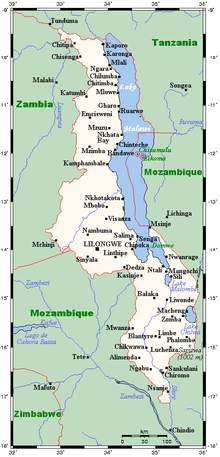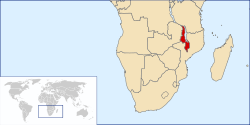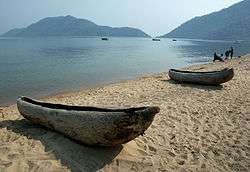Geography of Malawi


Malawi is a landlocked country in southeastern Africa. It is wholly within the tropics; from about 9°30S at its northernmost point to about 17°S at the southernmost tip. The country occupies a thin strip of land between Zambia and Mozambique protruding southwards into Mozambique along the valley of the Shire River. In the north and north east it also shares a border with Tanzania. Malawi is connected by rail to the Mozambican ports of Nacala and Beira. It lies between latitudes 9° and 18°S, and longitudes 32° and 36°E.
The Great Rift Valley runs through the country from north to south, and to the east of the valley lies Lake Malawi (also called Lake Nyasa), making up over three-quarters of Malawi's eastern boundary.[1] Lake Malawi is sometimes called the Calendar Lake as it is about 365 miles (587 km) long and 52 miles (84 km) wide.[2] The Shire River flows from the south end of the lake and joins the Zambezi River 250 miles (400 km) farther south in Mozambique. The surface of Lake Malawi is located at 1,500 feet (457 m) above sea level, with a maximum depth of 2,300 feet (701 m), which means the lake bottom is over 700 feet (213 m) below sea level at some points.
In the mountainous sections of Malawi surrounding the Rift Valley, plateaus rise generally 3,000 to 4,000 feet (914 to 1,219 m) above sea level, although some rise as high as 8,000 feet (2,438 m) in the north. To the south of Lake Malawi lie the Shire Highlands, gently rolling land at approximately 3,000 feet (914 m) above sea level. In this area, the Zomba and Mulanje mountain peaks rise to respective heights of 7,000 and 10,000 feet (2,134 and 3,048 m).[1]
Malawi's capital is Lilongwe, and its commercial centre is Blantyre with a population of over 500,000 people.[1] Malawi has two sites listed on the UNESCO World Heritage List. Lake Malawi National Park was first listed in 1984 and the Chongoni Rock Art Area was listed in 2006.[3]
Malawi's climate is hot in the low-lying areas in the south of the country and temperate in the northern highlands. The altitude moderates what would be an otherwise equatorial climate. Between November and April the temperature is warm with equatorial rains and thunderstorms, with the storms reaching their peak severity in late March. After March, the rainfall rapidly diminishes and from May to September wet mists float from the highlands into the plateaus, with almost no rainfall during these months.[1]
Landscape

The Great Rift Valley traverses the country from north to south. In this deep trough lies Lake Malawi, the third-largest lake in Africa, comprising about 25% of Malawi's area. The Shire River flows from the south end of the lake and joins the Zambezi River 400 kilometers (249 mi) farther south in Mozambique.
West of the Great Rift Valley, the land forms high plateaus, generally between 900 and 1,200 meters (2,953 and 3,937 ft) above sea level. In the north, the Nyika Uplands rise as high as 2,600 meters (8,530 ft). The area to the west of the lake in northern and central Malawi has been categorised by the World Wildlife Fund as part of the Central Zambezian Miombo woodlands ecoregion.
South of the lake lie the Shire Highlands, with an elevation of 600–1,600 meters (1,969–5,249 ft), rising to elevations of 2,130 and 3,002 meters (6,988 and 9,849 ft) at the Zomba Plateau and Mulanje Massif respectively. In the extreme south, the elevation is only 60–90 meters (197–295 ft) above sea level.
Malawi is one of Sub-Saharan Africa's most densely populated countries. The population of Lilongwe—Malawi's capital since 1971—exceeds 400,000. All government ministries and the Parliament are located in Lilongwe. Blantyre, Malawi remains Malawi's major commercial center and largest city, having grown from an estimated 109,000 inhabitants in 1966 to nearly 500,000 in 1998. Malawi's President resides in Blantyre. The Supreme Court is seated in Blantyre.
Malawi has five national parks:
- Cape Maclear National Park
- Kasungu National Park
- Lengwe National Park
- Liwonde National Park
- Nyika National Park
Climate
Malawi's climate is generally tropical. A rainy season runs from November to April. There is little to no rainfall throughout much of the country from May to October. It is hot and humid from September to April along the lake and in the lower Shire Valley, with average daytime maximum around 27 to 29 °C (80.6 to 84.2 °F). Lilongwe is also hot and humid during these months, albeit far less than in the south. The rest of the country is warm during those months with a maximum temperature during the day around 25 °C (77 °F). From June through August, the lake areas and south are comfortably warm, with daytime maxima of around 23 °C (73.4 °F), but the rest of Malawi can be chilly at night, with temperatures ranging from 10–14 °C (50.0–57.2 °F). High altitude areas such as Mulanje and Nyika are often cold at night (around 6–8 °C or 42.8–46.4 °F) during June and July. Karonga in the far north shows little variation in temperature with maximum daytime temperature remaining around 25 to 26 °C (77.0 to 78.8 °F) all year round but is unusual in that April and May are the wettest times of the year due to strengthening southerly winds along the lake.
Area
The total area of the country is 118,484 km², but this includes 24,404 km² of water surface, mainly composed of Lake Malawi, but there are other sizeable lakes, such as Lake Malombe, Lake Chilwa and Lake Chiuta. The land area is 94,080 km².
The country is dominated by Lake Malawi, which drains into the Zambezi River through the Shire River. As a result, the whole of the country, except for one eastern district is part of the Zambezi drainage system. Lake Chiuta and the surrounding plain is drained by the Lugenda river, which is part of the Ruvuma River drainage system. Lake Chilwa, about 35 km south of Lake Chiuta is unusual as it has no outlet although when it overflows it flows into Lake Chiuta through a swampy plain. High rates of evaporation ensure that the lake seldom fills up – much of the lake is only 1 metre deep or less.
Environment — current issues: Deforestation; land degradation; water pollution from agricultural runoff, sewage, industrial wastes; siltation of spawning grounds endangers fish populations
Environment — international agreements:
party to:
Biodiversity, Climate Change, Climate Change-Kyoto Protocol, Desertification, Endangered Species, Environmental Modification, Hazardous Wastes, Marine Life Conservation, Ozone Layer Protection, Ship Pollution, Wetlands
signed, but not ratified:
Law of the Sea
Extreme points
This is a list of the extreme points of Malawi, the points that are farther north, south, east or west than any other location.
- Northernmost point - the tripoint with Tanzania and Zambia, Northern Region
- Easternmost point - unnamed location on the border with Mozambique immediately south-west of the Mozambican village of Buena-uzi, Southern Region
- Southernmost point - unnamed location on the border with Mozambique immediately north-east of the Mozambican village of Jossene, Southern Region
- Westernmost point - unnamed location on the border with Zambia immediately east of the Zambian town of Chipata, Central Region